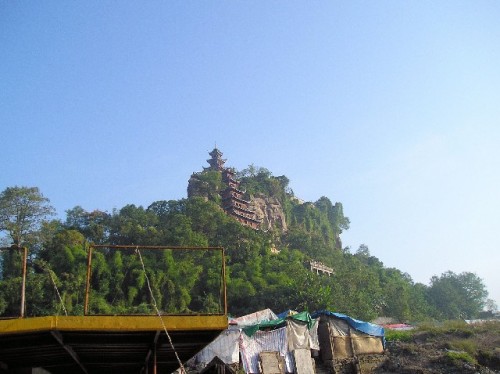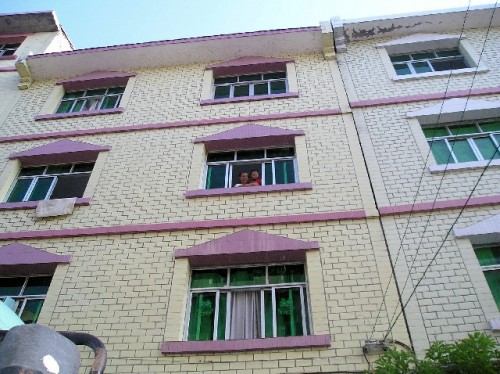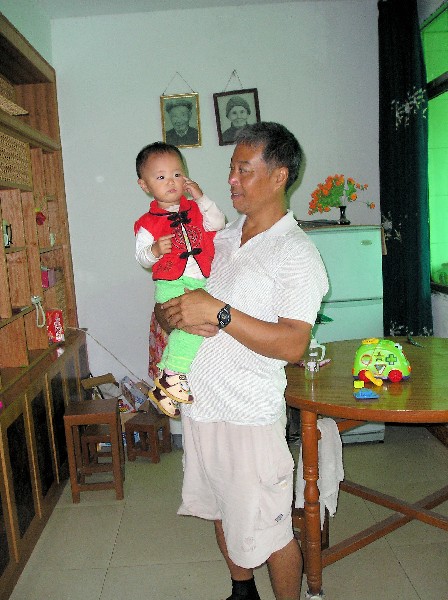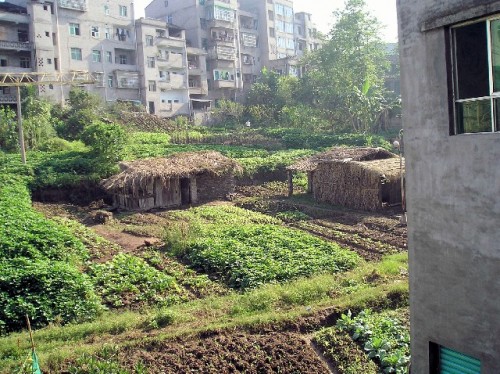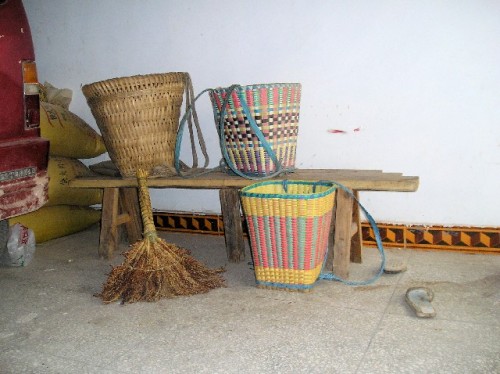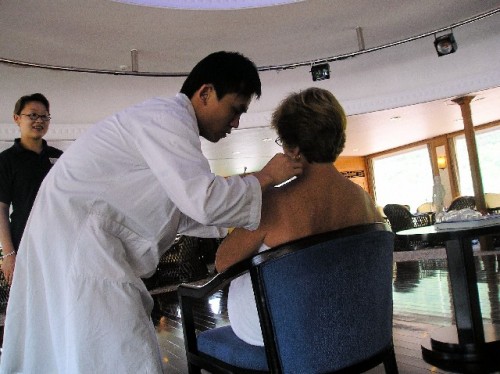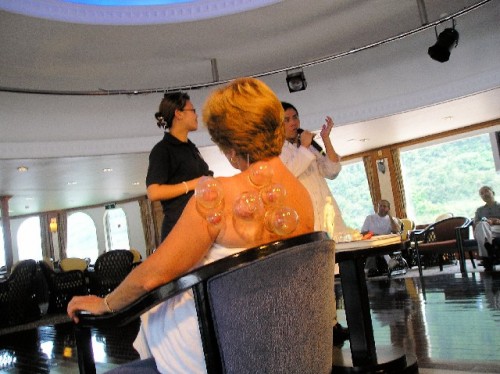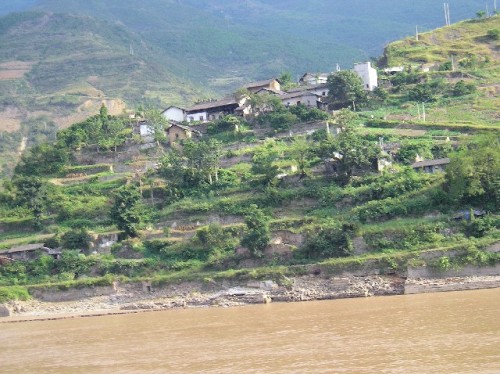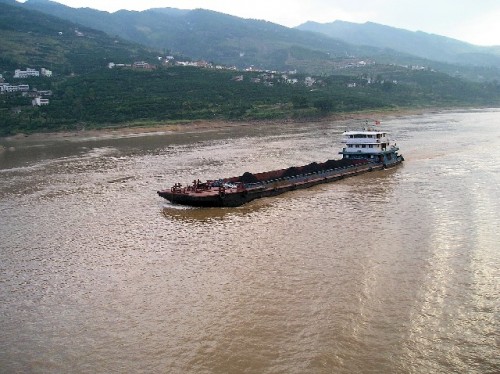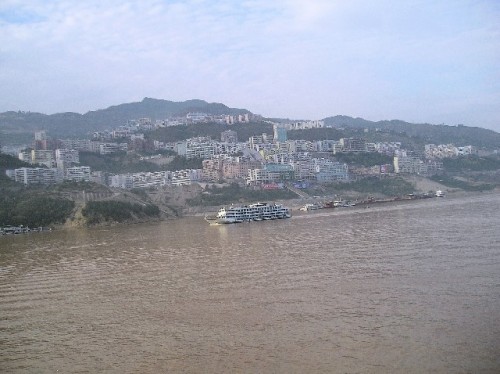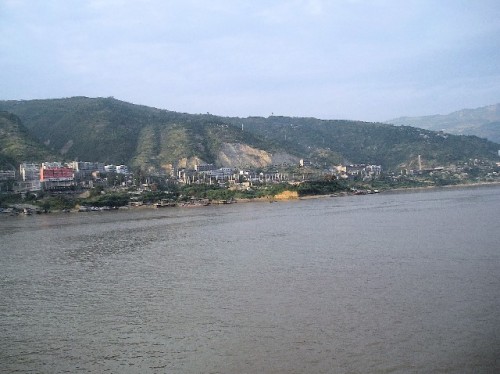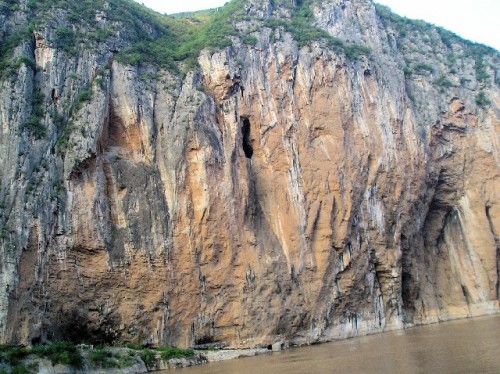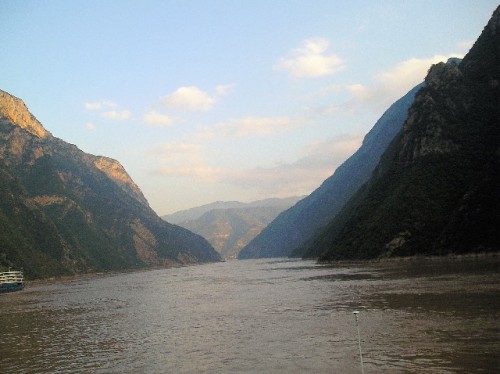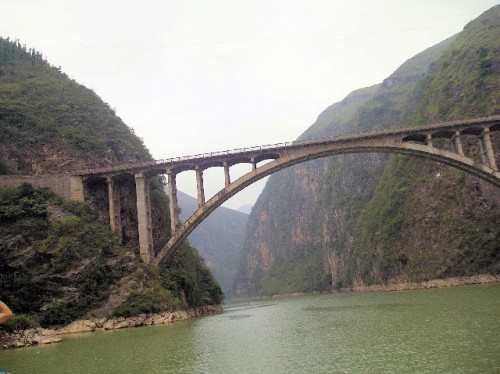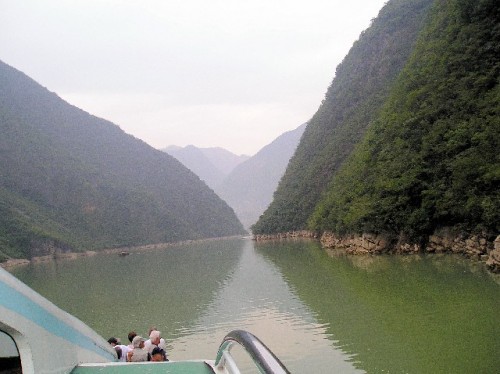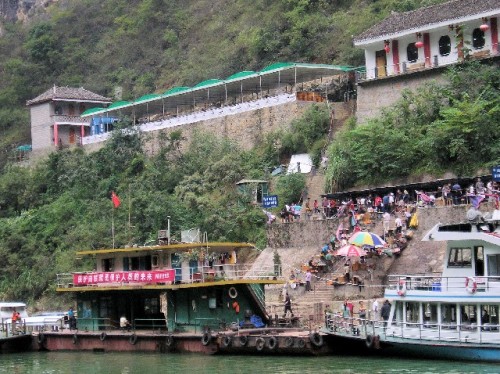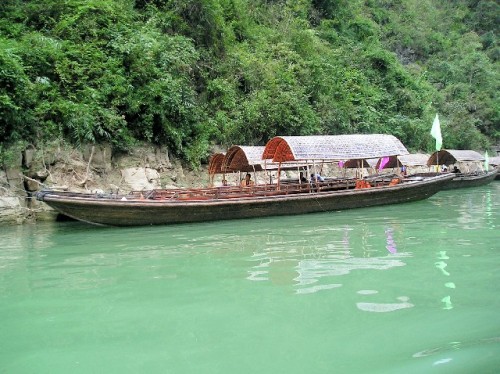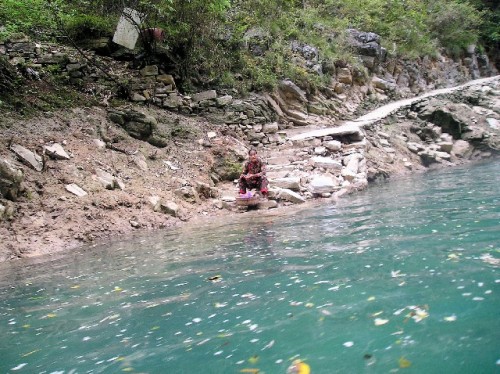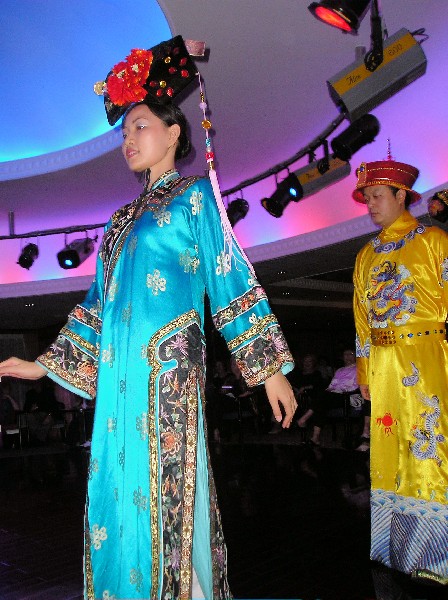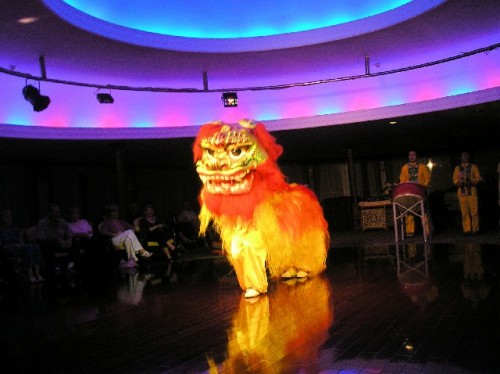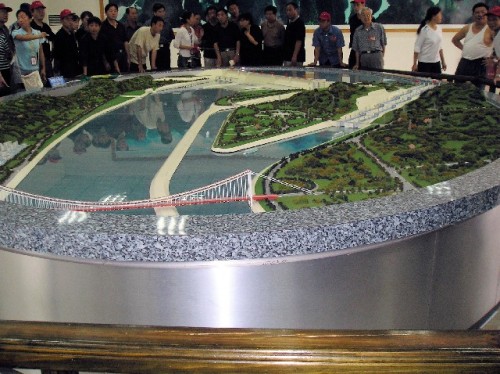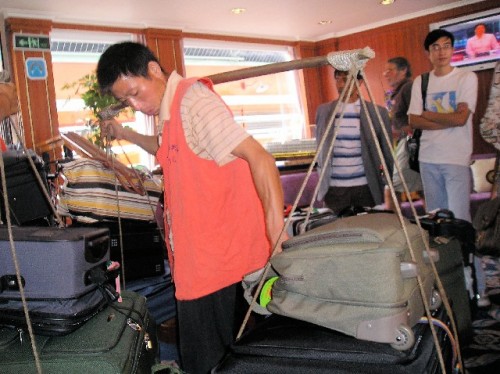Report on China: Part Five
Yangtze River
By: Zeren Earls - Jul 05, 2008
The Victoria Star set sail at 9 p.m. with 160 passengers. Old homes along the riverbank and apartment blocks set back on the hillside created a picturesque nightscape. These hills had been hideouts for soldiers during World War II as China fought against Japan; Chiang Kai-shek's Nationalist government, centered here, ended when he left for Taiwan in 1949. In the morning the ship docked at the famous Red Pagoda of Shibaozhai. The 12-story structure, built without any nails, rests against a massive rock behind it. The road to it is lined with stalls of local crafts. I bought a T-shirt splashed with bamboo images, accompanied by a poem in Chinese characters that read "No matter from which direction the wind blows, the bamboo will spread its young shoots".
Our group opted to visit a family that had lost its farmland to the dam project and been moved uphill by the government. The farmer was home taking care of his 18-month-old granddaughter; his wife was at the market selling. His daughter worked in a toy factory; his son was a chauffeur. His daughter-in-law, who was a sales clerk in the clothing section of a supermarket, came home only on weekends because of the hour-and-a-half commute each way. She rented a room near her job. Together with her husband she earned about $200 a month. To make ends meet, the family lived altogether in one apartment above the garage and rented the top two stories. The former farmer admitted that their living conditions had improved by moving to this two-bedroom apartment with interior plumbing, yet he missed working. Now he was a full time babysitter.
Back at the ship, we had an introductory lecture to the Yangtze River. After the Nile and the Amazon it is the world's 3rd longest river. It originates in the Himalayas in Tibet. Its upper reaches are dangerous for navigation. Its middle and lower section, which reach from Chongqing to Shanghai, are fertile lands. It has 700 tributaries; 450 million, a third of the country, live along its shores. They have cut down trees to develop farmland, created mudslides and ended the bird population; industrial plants have polluted the air and the waters, drastically reducing the numbers of dolphins, alligators and fish.
The Three Gorges Dam project is underway to control flooding; 200 floods to date have claimed 142,000 lives. 1.3 million people will be relocated; eight cities will be submerged and Chongqing will be on a big lake created by the new dam. Also, coal will be removed from the mines and buildings dynamited, in order to facilitate navigation. Started in1994 the dam project is 2/3 finished; it is China's biggest since the Great Wall. I looked out the window as I listened. The tranquil countryside where farmers burned garbage for fertilizer seemed oblivious to the future. China would change forever.
The three-day cruise was packed with opportunities to learn about cultural traditions. Dr. Hu made the first presentation on the 1000-years-old Chinese medicine, which emphasizes the whole body. The color of the face, tongue and palm indicates the balance of ying and yang. Treatment may be with 10,000 varieties of medicine or with alternatives such as acupuncture, acupressure, scraping and cupping, which is good for muscles and nerves. The body has fourteen main channels; the places, where they connect are the acupoints. Acupuncture needles stay in for fifteen minutes to open up blocked channels. He applied needles to a volunteer with stiff-arm and neck, and then cupped her back. The problem area swelled up and turned dark purple with the suction of the heated cup. He proceeded to show us the various pressure points for treating motion sickness, insomnia, stomach and toothaches.
Other lectures were on pearls and traditional painting. The Chinese have cultivated fresh water pearls since ancient times. They get an oyster to produce up to 20 pearls by introducing bits of soft muscle from another one as an irritant. The size of the pearl depends on the number of years it is kept in the water. The quality of the pearl depends on its size, roundness and lack of flaws. The different mineral elements in the water determine its color. Real pearls feel coarse and grainy, as opposed to smooth plastic ones.
Tools of traditional Chinese painting are: brushes of various thickness made of spring bamboo; goat, horse and wolf hair, depending on the detail desired; seals made of carved stone and inked in red; black "dragon" ink; and the ink stone. Traditionally in black and white, they are painted on silk or rice paper. For embroidery painting the design is first traced and then filled in with needlework. Mr. Gu demonstrated a painting for us.
It was exciting to enter the first of the Three Gorges: the Gutang Gorge carved by the river through limestone highlands. The shortest of the three, it took us 20 minutes to go through its dramatic sheer cliffs. Throughout history people have been in awe of these cliff faces, carving stairways, placing tombs and inscribing poems on the mountainside.
Following dinner, the talented cruise staff put on a fashion show modeling the exquisite silk costumes of the different dynasties, as well as a variety of traditional ones from all regions of China. It was great fun to see the evolution of costumes throughout history and then see the models in the modern outfits they wear today.
The next shore excursion took us to Wushan. We boarded a motorized boat down the Daning River through the scenery of the Lesser Three Gorges, spotting little monkeys and admiring the green waters of the Emerald Gorge. We then transferred to sampans to enjoy the shores of the Madu River. The sampan captain shared his straw fisherman's hat and goat hair cape for photo ops, as he threaded the boat through narrow passageways by steep rock walls. We passed by precipices, wooden coffins tucked into ledges by the ancient Ba people, high water marks, deep valleys, a lagoon where a villager sang as she did her laundry, a peddler's market, sweet potato crops and ducks.
Continuing down the Yangtze we entered the Wu Gorge, the second of the three, its sharp peaks jutting into the haze. Free-flowing imaginations spotted a beautiful girl on top of the mountain. The river traffic was brisk: government cruise ships, ferry boats taking people between towns on the river, cargo barges and hydrofoil speed boats that cover long distances in a short time. Mournful horns greeted one another as ships billowed black smoke. In two years the water will rise to 175 meters, so everything below that level is being taken down to avoid hazardous navigation and river pollution.
Strong winds prevented us from flying a kite on the top deck; however I attended a workshop on kites. In ancient times the Chinese used kites to send messages. The craft is passed on through generations. To make a kite, bamboo is bent into different shapes and covered with silk for durability. Afterwards images symbolizing good wishes are painted onto the silk: a dragon for power and prosperity, a catfish for good fortune or a butterfly for harmony, which is what I got.
A session called "China Today" was a time for questions and answers that gave us further insight. China has a serious water shortage that impacts 300 cities; it diverts water from south to north. Only 10% of the land is fertile; most of it is covered with big mountains. There are 900 million farmers, 75% of whom have no health care. 72% of the population has no health insurance; those who work for the government or industry do. 30% of the nation is members of the Communist party. Following high school, students apply to join the party. After a period of observation by officials and proof that they are atheists, they are allowed into the party. Men and women share military service. It is against the law to carry guns or knives. China imports oil from Russia; it has a 20-year national oil reserve for military use; it controls use of private cars. 72% of its energy comes from coal, 4% from nuclear power and the remainder from hydroelectricity. By bringing technology to the countryside, it is trying to balance the rural and urban population.
The Xiling Gorge, the last and the longest of the three, is known as the most treacherous historically. Navigational buoys surrounded us as we approached. We cleared military security and got in line, along with barges carrying lumber and coal to sail through the Three Gorges ship locks. Meanwhile we attended the Captain's Farewell Banquet, followed by the Victoria Cabaret, a talent show by crew and audience participants. We started at the second level of the river and had to move up to the fifth, which took about five hours, docking at Sandouping for the night. It was worth staying up till 1:30 a.m. to witness this exciting passage.
In the morning we visited the dam site, chosen on purpose near a granite quarry. To ensure the structure's strength, concrete is mixed with granite. Currently 17,000 Chinese are working on the dam day and night, down from 28,000 in its early stages. The dam will have 45 gates and 32 turbines, 13 of which are already working. Supervised by 2000 Chinese engineers, it is projected to cost 28 billion (US) dollars, including the relocation of people. In addition to controlling the area's severe flooding and harnessing much-needed hydroelectric potential, the dam will open up the Yangtze to 10,000-ton ships and the water collected will be used for irrigation.
Back at the ship, the big hit of the buffet lunch was the fried onion rings, as we set sail through the eastern section of the Xiling Gorge to Yi Chang port for the next leg of our trip. The porters' carrying our heavy luggage is an image of our disembarkation that will stay with me for a long time. Suitcases stacked in threes, looped by a rope and suspended from a yoke on their shoulders, smallish porters had to climb steep stairs to get to the buses waiting for us.
The port of Yi Chang is a new city of 4 million, mostly composed of relocated people. It is situated on low hills with tangerine and orange trees. Here we started another bus ride of five hours, this time on a bumpy single-lane road. We passed time by snacking or sleeping. Since we were traveling south it was getting warm. At each rest stop we loaded up with snacks: sweet potato crackers, peanuts, candied bananas, ice cream, cold drinks, etc. Workers expanding the road covered the freshly poured cement with wet rags to keep it from cracking. This technique I had never seen before. Until the road turned into two lanes, we got stuck behind a tarp-covered truck. Impatient drivers passed us on the right, but then we also came upon a truck that had gone off into a ditch.
The landscape changed into cotton fields, canola flowers and ponds with turtles. Because of the high nutrition value of turtles, people take turtle soup to hospital patients, and when the temperature hits 40° C in the summer, the food of choice is duck soup to cool off. We passed by storage areas that people rent to keep their valuables in for fear of floods. There were ancestral temples in the fields for burying containers of ashes following cremation. All land belongs to the government; farmers lease the land. Trucks speeded by loaded with oxygen tanks spitting white bubbles to keep the fish in transport alive. At the market the price of dead fish drops drastically. Finally we hit a three-lane highway with bike rails on the side. We were in Wuhan.
Wuhan is a city of eight million. As we drove through the streets it appeared to be a vibrant place with Budweiser and Coca Cola ads. We got there in the evening and were happy to be out of the bus. However, since we had a 9:00 flight to Hong Kong the next morning, we called it a day and happily settled into our hotel for a shower and dinner.
On October 1, China's National Day, we flew to Hong Kong for the finale of our tour.

